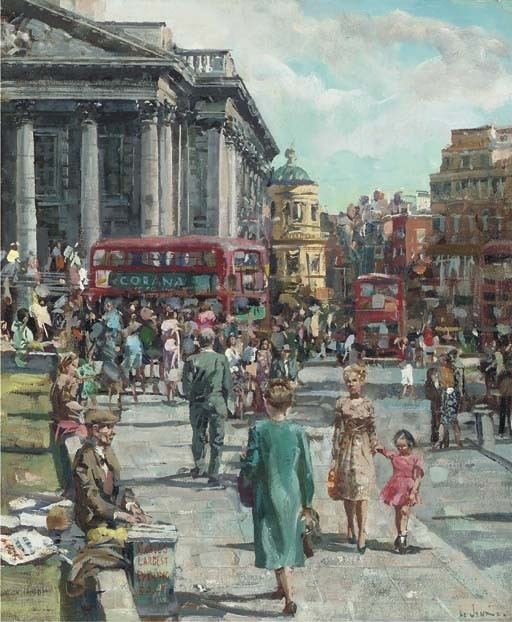Known for Painting Name James Jeune | Role Artist | |
 | ||
Full Name James George Le Jeune Died 1983, Blackrock, Dublin, Republic of Ireland | ||
James Le Jeune (1910 – 1983) was an Irish-Canadian artist who painted portraits, landscapes, and seascapes. Born in Saskatoon, Canada, Le Jeune grew up in Dinard in Brittany and later in England. After serving in the British Army in Africa and Italy during World War II, he moved to Ireland in 1950, where he was a regular art exhibiter at the Royal Hibernian Academy until a year before his death.
Contents

Early life

James George Le Jeune was born in Saskatoon, Canada on 24 May 1910. He was the son of Anthony Le Jeune, a musician, of English and French descent, and an Irish mother. His great uncle is the English Victorian artist/painter Henry Le Jeune. When he was two, his family moved to Dinard in Brittany where he attended a Christian Brothers School. He continued his education in a boarding school in Northampton, England.
Career
During his career, Le Jeune used oil, water-colour, pencil to paint portraits, landscapes, and seascapes. In the early 1930s, Le Jeune began training in art in Paris and later in London at Heatherley School of Fine Art and the Byam Shaw School of Art. He moved to the United States and attended the Art Students League in New York. Le Jeune also studied architecture at the London Polytechnic.
When World War II broke out, Le Jeune served in the British Army in Africa and Italy. Following the end of the war, he worked as an architect, but he had not lost his interest in painting. In 1948, Le Jeune exhibited at the Royal Institute of Oil Painters and the same year he exhibited Fishermans Regatta at the Society of Marine Artists.
In 1950, Le Jeune and his wife Pamela (née Mocatta) moved to Ireland to Delgany in County Wicklow, where he practised as an Architect for a short time but gave this up to paint full-time. In 1951, aged 41, Le Jeune began exhibiting at The Royal Hibernian Academy and was a regular exhibitor there for the next 31 years until 1982. During the 1950s, the Le Jeunes had three daughters, one of whom went on to be a self-taught artist.
His first one-man show was at the Victor Waddington Galleries in 1954. In 1956 he had an exhibition in the Little Theatre, Brown Thomas. Commenting on his Brown Thomas exhibit, The Dublin Magazine noted: "This artist's palette in landscape is inclined to be over-sombre; in his portraits on the other hand, his low tones give depth and background, and his subjects are almost startling in their truth and reality – seen with a touch of humour which stops short of caricature."
In 1960, Le Jeune moved to his studio at 38 Baggot Lane in Dublin, Ireland, where he lived and worked until his death in 1983. Jimmy, as he was known locally, was a regular visitor at Searsons pub and The Waterloo on Baggot Street. A year after he opened his Dublin studio, Le Jeune was appointed an associate of the Royal Hibernian Academy (RHA), an artist-based and artist-oriented institution in Ireland, founded in Dublin in 1823. From 1961 to 1972, he served as a member and became a full RHA member in 1973. During the late 1960s, Le Jeune opened an art studio in New York and divided his time for some years painting between the two cities.
Le Jeune died in Blackrock, County Dublin in January 1983. Writing for the Irish Independent twenty-five years later in 2008, journalist Con Houlihan, commented on his friend, "James was what you might call a painters' painter: he was greatly respected by his fellows but not as well known to the public. He had the invaluable gift of being able to laugh at himself. He was a brilliant catcher in the wry."
In March 1996, Le Jeune's Children Playing on a Beach painting sold for GB£8,700. In October of that same year, Le Jeune's Children Paddling Near Dalkey painting sold for GB£3,100 and his The Final/ Furlong painting sold for GB£2,450. Two months later, his Children Playing in a Garden painting sold for GB£8,000 and his Children on a Beach painting went for GB£6,200.
In December 2003, Le Jeune's At The Races – Longchamps painting sold for €12,000. In 2008, his the Perfect Storm – Waves Off Brittainy Coast sold for US$51,764.
Selected works
Examples of his work can be found in Newport Art Gallery, The National Gallery of Ireland, The National Self Portrait Collection of Ireland at the University of Limerick, The Abbey Theatre Dublin, Crawford Municipal Art Gallery Dublin, McKee Barracks, Kings Inns, and The United Arts Club.
